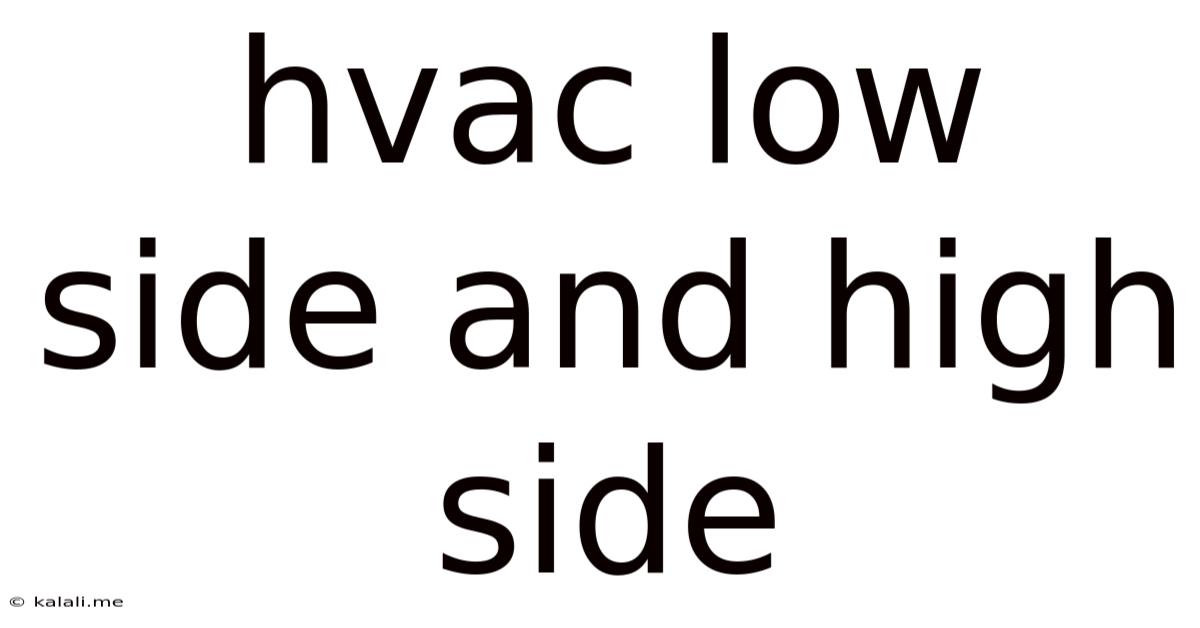Hvac Low Side And High Side
Kalali
Jun 10, 2025 · 3 min read

Table of Contents
Understanding HVAC Low Side and High Side: A Comprehensive Guide
Understanding your HVAC system's high and low sides is crucial for troubleshooting, maintenance, and ensuring optimal performance. This guide provides a clear explanation of the functions of each side, the pressures involved, and common issues that might arise. This information will help homeowners and technicians alike to better understand and maintain their HVAC systems.
What is the Low Side of an HVAC System?
The low side of your HVAC system refers to the section operating at lower pressure. This is where the refrigerant is in its gaseous state, having absorbed heat from your home. It’s characterized by lower pressure and temperature. Key components on the low side include:
- Evaporator Coil: This is where the refrigerant absorbs heat from the indoor air, causing it to cool down. The warm air from your home blows over the evaporator coil, cooling the air and transferring heat to the refrigerant.
- Refrigerant Suction Line: This line carries the low-pressure, gaseous refrigerant from the evaporator coil to the compressor. It's crucial for the refrigerant's efficient flow.
- Liquid Line Filter Drier: While technically a component of both sides, this filters out moisture and contaminants to protect the system.
- Metering Device (Expansion Valve or Capillary Tube): This component regulates the flow of refrigerant from the high-side to the low-side, controlling the amount of refrigerant entering the evaporator.
Understanding Low-Side Pressure: Lower pressure on the low side is normal and essential for proper heat absorption. Low side pressure readings are typically measured in pounds per square inch gauge (psig) and will vary depending on the specific refrigerant and ambient temperature. An abnormally low pressure often indicates a leak or other serious issue.
What is the High Side of an HVAC System?
The high side of your HVAC system operates at significantly higher pressure and temperature. Here, the refrigerant is compressed and releases its absorbed heat to the outside air. The key components include:
- Compressor: The heart of your HVAC system, the compressor compresses the low-pressure, gaseous refrigerant, raising its temperature and pressure.
- Condenser Coil: This is where the high-pressure, high-temperature refrigerant releases heat to the outdoor air. A fan helps dissipate this heat.
- Refrigerant Liquid Line: This line carries the high-pressure, liquid refrigerant from the condenser coil to the metering device.
- Condenser Fan Motor: This motor drives the fan that blows air across the condenser coil, assisting in heat dissipation.
Understanding High-Side Pressure: High-side pressure is also critical for proper system function. High pressures are necessary to facilitate the heat transfer process. However, excessively high pressure can indicate serious problems, such as a clogged condenser coil, a malfunctioning compressor, or a refrigerant overcharge.
Common Issues and Troubleshooting
Both the high and low sides can experience issues. Understanding these can aid in diagnosis:
- Low Refrigerant: This is a common problem that affects both sides, leading to poor cooling, reduced efficiency, and potential component damage. Leaks are a primary cause.
- Clogged Condenser Coil: This restricts airflow, leading to high high-side pressures and overheating.
- Compressor Failure: A malfunctioning compressor can cause significant issues on both sides, affecting refrigerant flow and pressure.
- Dirty Evaporator Coil: A dirty evaporator coil reduces heat transfer efficiency, affecting low-side pressure and cooling capacity.
- Malfunctioning Metering Device: An improperly functioning expansion valve or capillary tube can cause imbalances in refrigerant flow between the high and low sides.
Note: Diagnosing and repairing HVAC issues requires specialized knowledge and tools. Always consult a qualified HVAC technician for any repairs or maintenance.
Conclusion
Understanding the low side and high side of your HVAC system is vital for its proper functioning and longevity. By familiarizing yourself with these components and their roles, you can better monitor your system's performance and identify potential problems early on. Remember, regular maintenance and professional servicing are essential for preventing major issues and ensuring optimal cooling efficiency throughout the year.
Latest Posts
Latest Posts
-
How Many Cups In A 16 Oz Sour Cream
Jul 02, 2025
-
How Many 1 4 Teaspoons Are In 1 Teaspoon
Jul 02, 2025
-
How Many Tbsp In A Dry Ounce
Jul 02, 2025
-
How Do You Say Grandparents In Spanish
Jul 02, 2025
-
How Many Numbers Are Between 48 To 24
Jul 02, 2025
Related Post
Thank you for visiting our website which covers about Hvac Low Side And High Side . We hope the information provided has been useful to you. Feel free to contact us if you have any questions or need further assistance. See you next time and don't miss to bookmark.